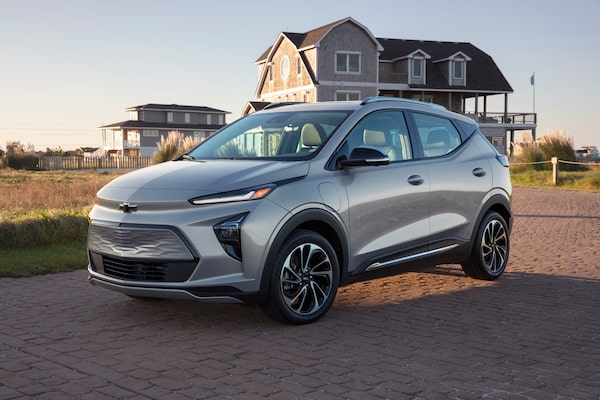
The 2023 Nissan Leaf.Jay McNally McNally Multi Media/Handout
Lovely, and very expensive electric vehicles are hitting the Canadian and American markets at a record pace.
I’m currently driving an old Nissan Leaf that I bought used five years ago now, and I’m looking for a replacement. I’m not looking at the large, very expensive vehicles. Manufacturers are missing a whole market segment – the simple, smaller battery, nonluxury EVs. Nissan failed to recapture its lead with the Leaf. The new one is barely worth looking at – too expensive for what it is.
There is a plethora of new, small, urban, parking-friendly vehicles coming that don’t have any chance in North America. Do they think we only want SUVs and trucks? What about those who want to spend more reasonable amounts for an electric car that is simple, serviceable and not expensive?
So what do I buy to replace my Leaf? – Clive
Mark Richardson: Clive is right – electric cars in Canada are expensive. There’s an awful lot of cutting-edge technology inside them, not to mention costly raw materials.
Petrina Gentile: And those prices of raw materials, like nickel and cobalt, are up from last year. Unfortunately, it’ll likely mean a high sticker price for EVs moving forward.
Richardson: Most of the “affordable” EVs in Canada start at a few bucks less than $45,000, because that’s been the maximum starting price for the $5,000 federal government rebate. Now the feds have upped that to $55,000, and I’m sure all those $45,000 prices will start rising, too.
Gentile: Let’s face it – $45,000 isn’t exactly affordable for most Canadians. Especially when you consider many of those lower-priced EVs are lacklustre and filled with plasticky interiors.

If Clive wants to spend a bit more to get more range, a new Chevy Bolt could do the trick.Courtesy of manufacturer
Richardson: This is why the government offers rebates, to soften the sticker shock. A $45,000 EV actually costs $40,000 everywhere in Canada, and in many provinces, there are further discounts to make the prices more affordable.
Gentile: In Quebec, there’s $8,000 in provincial rebates. Couple that with the $5,000 federal rebate and you’ll knock $13,000 of the price. That’s a huge price saving. In Ontario, there’s no provincial incentive – Premier Doug Ford scrapped it when he came to power in 2018. Most provinces, like Prince Edward Island, New Brunswick and even the Yukon now have them.
Richardson: Here in Canada, we don’t have the one-seater and micro-EVs found in other parts of the world because their makers don’t think they’ll sell here. Electra Meccanica, for example, is a B.C.-based maker of three-wheeled EVs, but it just doesn’t believe there’s a market yet to make it worthwhile to sell them in Canada. Mercedes tried with its tiny Smarts and couldn’t make a go of it.
Gentile: There’s definitely more choice in other parts of the world, besides North America. Clive is right – Nissan isn’t the leader any more. But I don’t mind the Leaf with the longer battery pack.
Richardson: There’s nothing wrong with the extended-range Leaf, whatever Clive might say. It can travel up to 363 kilometres on a warm day, and it’s one of the less-expensive options at around $40,000. But it’s sold out for this year. You can’t even order a 2023 model yet.
Gentile: True, but that’s the case with many EVs and new vehicles in general because of the global semiconductor chip shortage. Anything we recommend will have a wait-list. But I don’t think Clive should immediately discount the Leaf. It’s affordable, spacious and comes with many driver-assistance safety features.
Richardson: A four- or five-year-old Leaf is probably his best bet, but it will be costly now and his older Leaf won’t have much value left in it. The battery is probably past its warranty. It can be slow to charge as well, but if he’s charging mostly overnight at home, that’s not really an issue.
Gentile: Two of the least expensive EVs on the market are from Chevrolet – the Bolt hatchback and slightly larger Bolt EUV. After last year’s recall because of faulty batteries that could lead to fires, they’re finally trickling into dealerships.
Richardson: They’re becoming available now? It’s about time. If Clive is satisfied that the Bolt is now safe, it will probably be his best value.
Gentile: Agreed. There’s far less choice for small EVs in Canada compared to Europe, which has small, electrified Peugeots, Fiats and Vauxhalls. One vehicle that is often overlooked, but Clive might like, is the Kia Soul EV. That boxy design is unique and practical. It starts around $45,000, but he could get a used three- or four-year-old model for less.
The best value may be a four-year-old EV like the Kia Soul.Handout
Richardson: His best value is a four-year-old EV like the Soul or Leaf or Ford Fusion. He won’t get the range of today’s higher-priced models, nor the higher speed of charging, but he may not need that. He’s got to remember though: the less you want to spend, the less you’re going to get.
Gentile: Exactly. But if Clive wants to spend a bit more to get more range, a new Chevy Bolt or Nissan Leaf would do the trick.
What car should you buy? Write to Mark and Petrina at globedrive@globeandmail.com and use ‘What car’ as part of your subject line. Emails with different subject lines may not be answered.
Shopping for a new car? Check out the new Globe Drive Build and Price Tool to see the latest discounts, rebates and rates on new cars, trucks and SUVs. Click here to get your price.
 Petrina Gentile
Petrina Gentile Mark Richardson
Mark Richardson